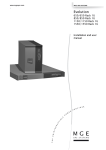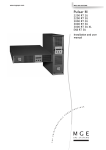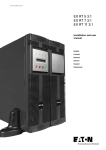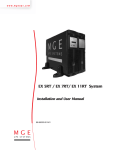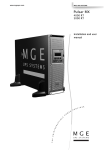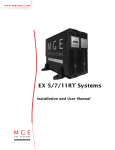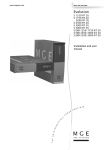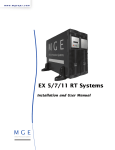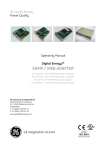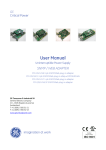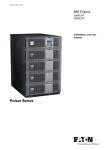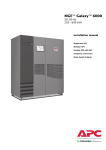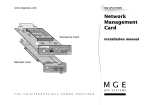Download MGE UPS Systems 4 User manual
Transcript
MGE UPS SYSTEMS
www.mgeups.com
Comet
EX 5 RT 3:1
EX 7 RT 3:1
EX 11 RT 3:1
Installation and user
manual
P
P
O
W
E
D E R
V I
O
R
R
T H E
U N
I N
T E
R
R
U
P
T
I
B
L
E
34007724EN/AA
- Page 1
Introduction
Thank you for selecting an MGE UPS SYSTEMS product to protect your equipment.
The Comet EX RT range has been designed with the utmost care.
We recommend that you take the time to read this manual to take full advantage of the many features of your UPS.
Warning: this is a class A UPS product. In a domestic environment, this product may cause radio interference, in which
case, the user may be required to take additional measures.
If the device must be installed in overvoltage category III or IV environments, additional upstream overvoltage protection
must be provided for.
To discover the entire range of MGE UPS SYSTEMS products and the options available for the Comet EX RT range,
we invite you to visit our web site at www.mgeups.com or contact your MGE UPS SYSTEMS representative.
Environmental protection
MGE UPS SYSTEMS cares about the environmental impact of its products and has therefore implemented an eco-design
process for the entire life cycle of the Comet EX RT product: design, usage and recycling.
Using this document
Information may be found primarily by checking:
◗ the contents,
◗ the index.
Icons
Important instructions that must always be followed.
Information, tips, help.
Visual indication.
Action.
Audible alarm.
In the illustrations on the following pages, the symbols below are used:
LED off.
LED on.
LED flashing.
Page 2 - 34007724EN/AA
Contents
1.
Presentation
1.1
Standard configurations .............................................................................................................. 5
Tower configuration ......................................................................................................................... 5
Rack configuration .......................................................................................................................... 5
1.2
Rear panels .................................................................................................................................... 6
Power module Comet EX 5 RT / EX 7 RT / EX 11 RT .................................................................... 6
Battery module Comet EXB 7 RT / EXB 11 RT ............................................................................... 6
1.3
1.4
Display and control panel ............................................................................................................ 7
Options .......................................................................................................................................... 7
Rack mounting kits .......................................................................................................................... 7
Transformer for galvanic isolation or earthing arrangement change .............................................. 8
Battery extensions for UPS backup times up to 60 minutes ........................................................... 9
CLA module (Long backup time charger) for backup times from 2 to 8 hours ................................ 9
Modules integration system .......................................................................................................... 10
Battery module with Remote Emergency Power Off function (REPO) ......................................... 10
Battery extension cable (1,8 m / 6 ft) ............................................................................................ 10
2.
Installation
2.1
Unpacking and parts check ....................................................................................................... 11
Power module ............................................................................................................................... 11
Battery module .............................................................................................................................. 11
2.2
2.3
Installation in tower configuration ............................................................................................ 12
Installation in rack configuration .............................................................................................. 13
Adjustment of the orientation of the logo and control panels ........................................................ 13
Battery module rack mounting (optional rail required) .................................................................. 13
Power or battery module rack mounting (optional rail required) ................................................... 14
2.4
Communication ports ................................................................................................................. 16
Connection to the RS232 communication port ............................................................................. 16
Connection to the communications port by relays ........................................................................ 16
Remote Power Off communication port ........................................................................................ 17
Installation of communication cards (optional, standard with the Network Pack version) ............. 17
2.5
Installation depending on the system earthing arrangement (SEA) ...................................... 18
UPS with common Normal and Bypass AC inputs ........................................................................ 18
UPS with separate Normal and Bypass AC inputs ....................................................................... 18
UPS with separate Normal and Bypass AC inputs, supplied by separate sources ....................... 19
Frequency converter (without Bypass AC input) ........................................................................... 19
Hot standby ................................................................................................................................... 19
2.6
Required protective devices and cable cross-sections .......................................................... 20
Recommended upstream protection ............................................................................................. 20
Recommended downstream protection ........................................................................................ 20
Required cable cross-section ........................................................................................................ 20
2.7
Connections of input/output power cables .............................................................................. 21
UPS with common Normal and Bypass AC sources ..................................................................... 21
UPS with separate Normal and Bypass AC sources .................................................................... 22
Frequency converter ..................................................................................................................... 23
Connection of battery cables ........................................................................................................ 24
Connection of galvanic isolation transformer ................................................................................ 24
Connection of CLA module ........................................................................................................... 25
34007724EN/AA
- Page 3
Contents
3.
Operation
3.1
Initial start up .............................................................................................................................. 26
UPS personalisation ..................................................................................................................... 26
Accessing personalisation with front panel buttons ...................................................................... 26
Access to the personalisation through external software .............................................................. 27
3.2
Final start up sequence .............................................................................................................. 27
3.3
Operating modes ........................................................................................................................ 28
Normal (double conversion) mode ................................................................................................ 28
Eco mode ...................................................................................................................................... 28
3.4
Operation on battery power ....................................................................................................... 29
Transfer to battery power .............................................................................................................. 29
Threshold for the low-battery warning ........................................................................................... 29
End of backup time ....................................................................................................................... 29
4.
3.5
Return of Normal AC source ...................................................................................................... 29
3.6
Shut down .................................................................................................................................... 30
Maintenance
4.1
4.2
Troubleshooting .......................................................................................................................... 31
Hot-swapping the power module .............................................................................................. 32
Disconnecting the power module .................................................................................................. 32
Reconnecting the power module .................................................................................................. 33
4.3
Hot-swapping the battery module ............................................................................................. 33
Disconnecting the battery module ................................................................................................. 33
Reconnecting the battery module ................................................................................................. 33
4.4
5.
Training center ............................................................................................................................ 34
Appendices
5.1
Technical specifications ............................................................................................................. 35
Electrical characteristics ............................................................................................................... 35
Thermal characteristics ................................................................................................................. 38
5.2
Page 4 - 34007724EN/AA
Glossary ....................................................................................................................................... 38
1. Presentation
1.1 Standard configurations
Tower configuration
Dimensions in mm/inches
(H x W x D)
Comet EX 5 RT
Comet EX 7 RT
Comet EX 11 RT
Comet EXB 7 RT
Comet EXB 11 RT
EXB
EX
11
444 x 131 x 635
17.49" x 5.16" x 25"
RT
Weight in kg/lbs
RT
ON
Comet EX 5 RT
Comet EX 7 RT
22.5 / 49.6
Comet EX 11 RT
27.5 / 60.6
Comet EXB 7 RT
64.5 / 142
Comet EXB 11 RT
68.5 / 151
OFF
www
www
.mge
ups.c
om
.mge
ups.c
om
Battery module
(Comet EXB 7 RT / EXB 11 RT)
Power module
(Comet EX 5 RT / EX 7 RT / EX11 RT)
Rack configuration
Power module (Comet EX 5 RT / EX 7 RT / EX11 RT)
Dimensions in mm/inches
(H x W x D)
Comet EX 5 RT
Comet EX 7 RT
Comet EX 11 RT
Comet EXB 7 RT
Comet EXB 11 RT
131 (3U) x 444 x 635
5.16" (3U) x 17.49" x 25"
Weight in kg/lbs
1 RT
EX 1
ON
OFF
www.mg
eups.co
eups.co
22.5 / 49.6
Comet EX 11 RT
27.5 / 60.6
Comet EXB 7 RT
64.5 / 142
Comet EXB 11 RT
68.5 / 151
m
EXB
www.mg
Comet EX 5 RT
Comet EX 7 RT
RT
m
Battery module
(Comet EXB 7 RT / EXB 11 RT)
34007724EN/AA
- Page 5
1. Presentation
1.2 Rear panels
Power module Comet EX 5 RT / EX 7 RT / EX 11 RT
1
Slot for communication cards.
2
Communication port by relays.
3
Remote Emergency Power Off communication port (REPO).
4
Connectors for automatic detection of battery module(s).
5
RS232 communications port.
6
Battery module connectors (to the UPS or to other battery
modules).
7
Manual Bypass switch.
8
Output terminal block.
9
Normal AC source circuit-breaker.
1
2
3
4
5
6
7
NORMAL
BY
PASS
10
9
8
10 Normal AC source terminal block.
11 Bypass AC source terminal block.
11
Battery module Comet EXB 7 RT / EXB 11 RT
4
Connectors for automatic detection of battery module(s).
6
Battery module connectors (to the UPS or to other battery
modules).
12 Battery circuit breaker.
4
6
12
Page 6 - 34007724EN/AA
1. Presentation
1.3 Display and control panel
13
14
15
16
13 Load protected LED.
14 Operation on battery LED.
E X 1 1 R T 3:1
15 Operation on bypass LED.
16 Fault LED.
17 Alphanumeric display.
18 UPS OFF button.
17
LOAD LEVEL
4 kW / 5 kVA
OFF
18
19 20 Function buttons (scroll up / scroll
down).
21 UPS ON button (or function button in
personalisation mode).
ON
19
20
21
1.4 Options
Rack mounting kits
Telescopic rails for Power module mounting in 19" enclosure with mounting hardware
(Part number 68001)
22 Ear hangup.
22
23 Rear bracket system for transportation.
23
25
24 Telescopic rails, 639 mm to 1005 mm
length (27.36" to 39.96").
24
25 Input/Output box bracket system.
Telescopic rails for Battery module mounting in 19" enclosure with mounting hardware
(Part number 68002)
22 Ear hangup.
22
23 Rear bracket system for transportation.
23
24 Telescopic rails, 639 mm to 1005 mm
length (27.36" to 39.96").
25
34007724EN/AA
- Page 7
1. Presentation
Transformer for galvanic isolation or earthing arrangement change
(Part number 68003)
This module is necessary either when a downstream neutral system from the UPS upstream is required, or when a
different power source connects the automatic bypass for higher availability.
EX
Transform
RT
www.m
geups.
er
com
Example of EX RT transformer connected upstream for Comet EX RT galvanic isolation
Battery module (Comet EXB RT)
Power module
(Comet EX 5 RT / EX 7 RT / EX 11 RT)
Transformer module (Comet EX RT)
Normal AC input
NORMAL
UPS output to load
BY
PASS
Bypass AC input
Page 8 - 34007724EN/AA
1. Presentation
Battery extensions for UPS backup times up to 60 minutes (at full load)
Comet EX RT offers a standard backup time of 5/9 minutes at full load.
To increase backup time, it is possible to connect Comet EXB 7 RT / EXB 11 RT modules to the UPSs.
Battery extensions for Comet EX 5 RT, Comet EX 7 RT or Comet EX 11 RT
Comet EX 5/7 RT
+ EXB 7 RT
/
Comet EX 11 RT
+ EXB 11 RT
+
Comet
EXB 7 RT
/
Comet
EXB 11 RT
+
Comet
EXB 7 RT
/
Comet
EXB 11 RT
+
Comet
EXB 7 RT
/
Comet
EXB 11 RT
+
Comet
EXB 7 RT
/
Comet
EXB 11 RT
+
Comet
EXB 7 RT
/
Comet
EXB 11 RT
5 kVA:
9 min
26 min
42 min
60 min
72 min
87 min
7 kVA:
7 min
20 min
32 min
45 min
57 min
70 min
11 kVA:
5 min
14 min
22 min
30 min
42 min
53 min
CLA module (Long backup time charger) for backup times from 2 to 8 hours
(Part number 68004)
Very long backup times, from 2 to 8 hours at full load, require a Comet EX RT CLA module.
Comet
EX 5 RT /
EX 7 RT /
EX 11 RT
Comet
EX RT CLA
50A
NORMAL
BY
PASS
~
Battery backup time
Recommended batteries for:
Comet EX5 RT Comet EX7 RT
Comet EX11 RT
2 hours
50 Ah
65 Ah
100 Ah
4 hours
100 Ah
130 Ah
200 Ah
8 hours
200 Ah
260 Ah
400 Ah
Total battery voltage : 240 V DC (20 x 12V DC).
The battery capacity must be set within the UPS (5 Ah increment possible, see UPS Personalisation section).
34007724EN/AA
- Page 9
1. Presentation
Modules integration system (Part number 68005)
RT
EXB
Transformer module
www.mgeu
ps.com
Modules integration system for extended
backup time configurations to conveniently
stack and secure up to 8 modules on the
same cart (swivel wheels with brakes,
leveling feet, seismic side panels, plates to
lock modules and screws included).
RT
EX 11
Power module
ON
OFF
www.mgeu
ps.com
RT
EXB
www.mgeu
ps.com
RT
EXB
www.mgeu
ps.com
RT
EXB
www.mgeu
ps.com
Batteries modules
RT
EXB
www.mgeu
ps.com
RT
EXB
www.mgeu
ps.com
RT
EXB
www.mgeu
ps.com
Battery module with Remote Emergency Power Off function (REPO)
Part number:
EXB 7 RT EPO: 68079.
EXB 11 RT EPO: 68119.
12
Battery circuit breaker with Remote Emergency Power OFF shunt trip.
Battery extension cable (1,8 m / 6 ft, Part number 68006)
This extended battery cable will be used instead of the standard battery cable when battery modules are distant from each
other (located in two different enclosures, for instance).
Page 10 - 34007724EN/AA
2. Installation
2.1 Unpacking and parts check
Power module
EX
11
RT
23
22
24
30
26
31
25
IP=
MAC=00E0D8FF855E
100
10
Reset
Card Settings
UPS
data
1 2
ON
RS232 Download
ETHERNET
RS232
66074
Battery module
EXB
RT
27
28
29
32
25
22 Two sets of tower stands.
27 Tower stand expanders.
23 RS232 communications cable.
28 Battery cable.
24 Product documentation.
29 Battery communication cable.
25 Telescopic rails for rack enclosure with
mounting hardware (optional, or standard with
Network Pack version).
26 Solution-Pac power management suite CDROM.
24
30 Input/Output junction box (with 11 insulated ferrules).
31 Network Management card (optional, or standard in Network
Pack version).
32 Bezel screw driver.
Packaging must be destroyed according to waste management standards. Recycling icons are displayed for easy
selection.
A dangerous voltage is present inside the power module and the battery module. Any operations to be carried out
on these modules must be done so by qualified staff.
34007724EN/AA
- Page 11
2. Installation
2.2 Installation in tower configuration
Use the tower stand template provided with the battery module.
2
2
1
1
EXB
EX
11
RT
RT
ON
OFF
www
www
.mge
ups.c
.mge
ups.c
om
om
3
3
4
4
4
4
Follow steps 1 to 4 to adjust the tower stands for the upright position.
Page 12 - 34007724EN/AA
2. Installation
2.3 Installation in rack configuration
We recommend to mount the battery module first, then mount the power module above the battery module.
Adjustment of the orientation of the logo and control panels
1 RT
EX 1
EX
11
OFF
RT
ON
www.mgeups.com
OFF
ON
om
www.m
EX
11
OFF
RT
4
ON
www.mgeups.com
1
geups.c
2
5
1 RT
EX 1
om
geups.c
www.m
3
ON
OFF
6
Battery module rack mounting (optional rails required, part number: 68002)
The battery module is very heavy. To ease its rack integration, we strongly recommend to remove the battery trays as
explained below:
2
RT
EXB
2
www.m
1
3
geups.c
om
1
x6
1
3
4
4
34007724EN/AA
- Page 13
2. Installation
5
6
Power or battery module rack mounting (optional rails required, part number: 68001)
Follow steps 1 to 4 for rack mounting the UPS onto the rails.
3
3
3
1
3
2
4
1
The rails and the necessary mounting hardware are supplied by MGE UPS SYSTEMS.
Note for step 1: it is possible to adjust the position of both front mounting ears.
Page 14 - 34007724EN/AA
4
2. Installation
Rear bracket system (included with rail kits, part numbers 68001 and 68002)
To be used if you need to move the rack
enclosure with UPS already rack-mounted
inside.
1
1
3
2
2
Input/output junction box bracket system (included with power module rail kit, part number 68001)
This bracket will maintain the Input/Output box at the rear of the rack enclosure when hot-swapping the power module.
It will then be easier to slide the replacement module into the connectors of the Input/Output box.
1
2
4
4
3
34007724EN/AA
- Page 15
2. Installation
2.4 Communication ports
Comet EX RT provides 3 communication methods that can be used simultaneously:
◗ The COM port provides RS232 communications using MGE UPS SYSTEMS SHUT protocol. Compatible with most power
management software applications available into the enclosed Solution Pac CD-Rom.
◗ The output contact port is used for basic signaling or for protection of IT systems like IBM iSeries (formerly AS400) and
more.
◗ The slot is compatible with any MGE UPS SYSTEMS communication card (check www.mgeups.com web site for the
complete list of compatible cards).
Connection to the RS 232 communication port
1 - Connect the RS 232 23 communications
cable to the serial port on the computer.
23
2 - Connect the other end of the
communications cable 23 to the RS 232 5
communications port on the UPS.
The UPS can now communicate with various
MGE UPS SYSTEMS power management
application software. Please note that the
configuration software is included with
Personal Solution Pac for Windows.
5
NORMAL
BY
PASS
Connection to the communication port by relays
2
Pin 1, 2: not used,
Pin 3: Remote Power Off signal (5 to 27 V DC, 10 mA max),
◗ Pin 4: Operation on mains (not on battery),
◗ Pin 5: User common,
◗ Pin 6: Operation on automatic by-pass,
◗ Pin 7: Low battery,
◗ Pin 8: Load protected,
◗ Pin 9: Operation on battery.
n.o.: contact normally open.
n.c.: contact normally closed.
◗
◗
5
4
9
n.c.
n.o.
3
8
n.o.
2
7
1
6
n.o.
n.o.
common
When the status is active, the contact between the common (Pin 5) and the relevant information pin is closed.
Output relays specifications
Voltage: 48 V DC max,
Current: 2 A max,
◗ Power: 62,5 VA, 30 W.
Example: for 48 V DC, Imax=625 mA
◗
◗
Page 16 - 34007724EN/AA
2. Installation
Remote Power Off communication port
3
Used in conjunction with the optional EPO battery module, this port enables total isolation of all power sources connected
to the UPS in case of emergency (the cable is not provided).
Remote power off contact normally open
RJ11
Remote power off contact normally closed
RJ11
654321
654321
5 V DC to 27 V DC
5 V DC to 27 V DC
◗ Signal:
- activation voltage: 5 V DC to 27 V DC.
- current: 10 mA max.
Installation of communication cards (optional, standard with the Network Pack version)
Communication card.
1
IP=
MAC=00E0D8FF855E
100
10
Reset
Card Settings
UPS
data
1 2
ON
RS232 Download
RS232
ETHERNET
66074
It is not necessary to shut down the UPS to
install the communication card:
1 - Remove the slot cover secured by two
screws.
2 - Insert the card 1 into the slot.
3 - Secure the card with both screws.
NORMAL
BY
PASS
34007724EN/AA
- Page 17
2. Installation
2.5 Installation depending on the system earthing arrangement (SEA)
Comet EX must be fed from a 3-phase source with neutral.
UPS with common Normal and Bypass AC inputs
Main lowvoltage
switchboard
(MLVS)
11
Bypass AC
Normal AC
10
8
load
Change in SEA between upstream and downstream or galvanic isolation required
Main lowvoltage
switchboard
(MLVS)
Bypass AC
11
10
8
load
8
load
Normal AC
UPS with separate Normal and Bypass AC inputs
Main lowvoltage
switchboard
(MLVS)
Bypass AC
11
(*)
10
Normal AC
Change in SEA between upstream and downstream or galvanic isolation required
Main lowvoltage
switchboard
(MLVS)
Bypass AC
11
(*)
10
8
load
Normal AC
(*): The transformer is not necessary if:
◗ Normal and Bypass AC inputs are connected to the same source,
◗ and wires cross sections and wires lengths on Normal and Bypass inputs are identical,
◗ and upstream protection is provided by only one switch with RCD (residual current device) for Normal and Bypass inputs.
Page 18 - 34007724EN/AA
2. Installation
UPS with separate Normal and Bypass AC inputs, supplied by separate sources
Bypass AC
MLVS 1
11
MLVS 2
10
8
load
8
load
Normal AC
or
Bypass AC
MLVS 1
11
MLVS 2
10
Normal AC
Change in SEA between upstream and downstream or galvanic isolation required
Bypass AC
11
MLVS 1
10
MLVS 2
8
load
Normal AC
Frequency converter (without Bypass AC input)
Configuration used when the frequency of the application differs from the Mains (Example: marine requirements).
Main lowvoltage
switchboard
(MLVS)
11
10
8
load
Normal AC
Hot stand by
Configuration used to provide full redundancy (N+1) to critical loads.
Main lowvoltage
switchboard
(MLVS)
Bypass AC
11
10
8
Normal AC
(*)
(see page 18)
11
Normal AC
10
8
load
34007724EN/AA
- Page 19
2. Installation
2.6 Required protective devices and cable cross-sections
Recommended upstream protection
UPS
Common AC inputs
power
Upstream circuit-breaker
Upstream circuit-breaker
Upstream circuit-breaker
rating
Normal / Bypass AC sources
Normal AC source
Bypass AC source
5 kVA
D curve - 40A
C curve - 32A
D curve - 40A
7 kVA
D curve - 40A
C curve - 32A
D curve - 40A
11 kVA
D curve - 63A
C curve - 63A
D curve - 63A
Separate AC inputs
Note: see the simplified diagrams in the appendix for common or separate AC inputs, indicating the positions of the
protection devices, the characteristics of the internal UPS fuses and UPS line currents under overload conditions.
Recommended downstream protection
UPS power
Downstream
rating
circuit breaker
5 kVA
Z curve - 10A
7 kVA
Z curve - 10A
11 kVA
Z curve - 10A
C curve - 4A
C curve - 4A
The indicated protection ensures
discrimination for each output circuit
downstream of the UPS, whether supplied
by the Normal or the Bypass AC source.
If these recommendations are not followed,
protection discrimination is not achieved and
may result in a potential power interruption
to the connected devices.
C curve - 6A
Note: see the simplified diagrams in the appendix for common or separate AC inputs, indicating the positions of the
protection devices, the characteristics of the internal UPS fuses and UPS line currents under overload conditions.
Required cable cross-sections
◗
◗
Page 20 - 34007724EN/AA
Terminal-block cable capacity: 10 mm2, solid or stranded wire (maximum 13 mm2 or AWG 6).
Capacity for earthing conductor: 10 mm2, solid or stranded wire (maximum 13 mm2 or AWG 6).
2. Installation
2.7 Connections of input/output power cables
This type of connection must be carried out by qualified electrical personnel.
Before carrying out any connection, check that the battery circuit breaker 12 and that the upstream protection devices
(Normal and Bypass AC sources) are open ("0").
◗ Comet EX RT UPS always comes from factory with Normal and Bypass AC inputs already connected together, using a
bridge.
◗ Use included insulated ferrules with stranded wires.
◗
◗
UPS with common Normal and Bypass AC sources
t
Outpu
N
N1
ut
ier Inp
Rectif
L1
L2
L3
L
s Input
Bypas
L2
N2
L1
1
1
t
Outpu
N
N1
ut
ier Inp
Rectif
L1
L2
L3
1
1
1
5
s Input
Bypas
L2
N2
4
2
3
t
Outpu
N
N1
ut
ier Inp
Rectif
L1
L2
L3
6
Always connect the earthing
wire first.
4 - Insert the output cable to the load
through the output cable gland,
5 - Connect the 3 wires to the output
terminal block,
6 - Refit the terminal block cover and tighten
the cable glands,
7 - Secure the junction Input/Output box to
the rear of the power module by means of
the 3 screws.
L
L1
To access the connection terminal blocks,
see section 1.2 "Rear panel":
1 - Remove the terminal block cover
(5 screws),
2 - Insert the Normal AC cable through the
cable gland,
3 - Connect the 5 wires to the Normal AC
terminal block,
L
s Input
Bypas
L2
N2
L1
6
6
6
6
7
AL
NORM
7
10
100
Reset
1 2
ON
IP=
MAC=00E0D8FF855E
7
RS232 Download
ETHERNET
UPS
data
Card Settings
66074
φ
34007724EN/AA
- Page 21
2. Installation
UPS with separate Normal and Bypass AC sources
t
Outpu
N
N1
ut
ier Inp
Rectif
L1
L2
L3
L
s Input
Bypas
L2
N2
2
L1
1
1
1
t
Outpu
N
N1
1
1
ut
ier Inp
Rectif
L1
L2
L3
L
6
L1
5
4
3 7
t
Outpu
N
N1
ut
ier Inp
Rectif
L1
L2
L3
L
s Input
Bypas
L2
N2
L1
9
9
9
9
9
10
10
100
Reset
1 2
ON
IP=
MAC=00E0D8FF855E
RS232 Download
ETHERNET
UPS
data
Card Settings
66074
φ
Page 22 - 34007724EN/AA
Always connect the earthing
wire first.
5 - Insert the Output cable to the load
through the Output cable gland,
6 - Connect the 3 wires to the output
terminal block,
7 - Insert the Bypass cable through the cable
gland,
8 - Connect the 3 wires to the Bypass AC
terminal block,
9 - Refit the terminal block cover and tighten
the cable glands,
10 - Secure the junction Input/Output box to
the rear of the power module by means of
the 3 screws.
s Input
Bypas
L2
N2
8
1 - Remove the terminal block cover
(5 screws),
2 - Remove the bridge connected between
L2 and L1,
3 - Insert the Normal AC cable through the
cable gland,
4 - Connect the 5 wires to the Normal AC
terminal block,
AL
NORM
10
10
2. Installation
Frequency converter
t
Outpu
N
N1
ut
ier Inp
Rectif
L1
L2
L3
L
s Input
Bypas
L2
N2
2
L1
1
1
1
1
1
1 - Remove the terminal block cover
(5 screws),
2 - Remove the bridge connected between
L2 and L1,
3 - Insert the Normal AC cable through the
cable gland,
4 - Connect the 5 wires to the Normal AC
terminal block,
Always connect the earthing
wire first.
5 - Insert the Output cable suppling the load
through the Output cable gland,
6 - Connect the 3 wires to output terminal
block,
t
Outpu
N
N1
ut
ier Inp
Rectif
L1
L2
L3
Do not connect anything to the
Bypass AC terminal block,
L
6
s Input
Bypas
L2
N2
L1
7 - Refit the terminal block cover and tighten
the cable glands,
8 - Secure the junction Input/Output box to
the rear of the power module by means of
the 3 screws.
5
4
3
t
Outpu
N
N1
ut
ier Inp
Rectif
L1
L2
L3
L
s Input
Bypas
L2
N2
L1
7
7
7
7
7
8
AL
NORM
8
10
100
Reset
1 2
ON
IP=
MAC=00E0D8FF855E
8
RS232 Download
ETHERNET
UPS
data
Card Settings
66074
φ
34007724EN/AA
- Page 23
2. Installation
Connection of battery cables
4
29
28
1 - Check that the battery circuit breaker 12
is OFF ("0" position),
2 - Connect the battery power cable 28 to
the connectors 6 of the power and battery
modules,
3 - Connect the battery detection cable 29
to the connectors 4 of the power and
battery modules,
6
NORMAL
BY
PASS
12
Connection of galvanic isolation transformer
INPUT
N
L
OUTPUT
N
L
Transformer Input
Transformer Output
Output cable cross-section (not provided): 10 mm2, solid or stranded wire (maximum 13 mm2 or AWG 6).
◗ Input cable cross-section (not provided): 10 mm2, solid or stranded wire (maximum 13 mm2 or AWG 6).
◗
Page 24 - 34007724EN/AA
2. Installation
Connection of CLA module
29
BATTERY
28
_
+
AC INPUT
N
L
NORMAL
To battery
BY
PASS
AC Input
Connect the battery cable 28 (provided with the CLA module) between the power module and the CLA module.
Connect the cable 29 (provided with the CLA module) between the power module and the CLA module.
◗ Connect the battery:
◗ Cable cross-section (not provided): 10 mm2, solid or stranded wire (maximum 13 mm2 or AWG 6).
◗ Use a circuit-breaker (curve B, 50 A) for cable protection.
◗ Connect the input cable of the CLA module to the AC input:
◗ AC input cable cross-section (not provided) : 2,5 mm2.
◗ Use a circuit-breaker (curve C, 10 A) for cable protection.
◗
◗
34007724EN/AA
- Page 25
3. Operation
3.1 Initial start up
Check that the manual bypass switch 7 is on Normal position.
Set the normal AC source circuit-breaker 9 to the "I" position.
Set the battery circuit breaker 12 to the "I" position.
15
The load is powered via the bypass AC source, but not protected
by the UPS.
Batteries are recharging, an eight-hour recharge period is
necessary to get full backup time.
LED 15 is ON.
PRESS ON
TO START UPS
OFF
ON
UPS personalisation
If specific settings are required, it is recommended to enter the UPS personnalisation mode at this stage.
It is possible to enter this mode through the front panel buttons or the Personal Solution-Pac software for Windows
included in the MGE UPS SYSTEMS Solution-Pac power management suite CD-ROM.
Accessing personalisation with front panel buttons
Press "scroll up" 19 and "scroll down" 20 function buttons together
for more than 3 seconds.
◗ Press the function button 20 placed under the ENT word to enter the
set up mode and follow the LCD messages using the buttons now
defined as select keys.
◗
UPS SET UP
EXIT
ENT
OFF
ON
19
20
Local settings
Factory setting
Function
Options
Language
English
French, Spanish, German, Italian.
Date / time format
International format
US format (MM-DD-YYYY/HH:MM AM/PM).
(DD-MM-YYYY/HH:MM)
Date / time change
Time in France
MM-DD-YYYY/HH:MM adjustable.
Audible alarm
Quick beeps
Slow beeps.
Output features
Factory setting
Function
Comments
Options
Output voltage
230 Volts AC
200/208/220/240/250
Frequency converter
Disabled
Enabled
Bypass AC source disabled.
Output frequency
Auto ranging
50/60 Hz
User selectable under frequency converter
mode.
Eco mode
Disabled
Enabled
See glossary.
Hot standby
Disabled
Enabled
N+1 redundancy
(See section 2.5 "Hot standby").
Operating mode
Industrial
I/T Network
(*)
Transfer on Bypass AC
If the Bypass AC source is
If the Bypass AC source is
(*)
source
out of tolerances
inside tolerances
Break time
10 ms
10 to 200 ms
Break time calibration during load transfer
(by steps of 10 ms)
on Bypass AC source out of tolerances.
Overload level
102%
50/70%
(*) : - Select "I/T Network" and "AC Bypass within tolerance" for computer loads.
- Select "Industrial" and "AC Bypass out of tolerance" in case of absolute need for service continuity (with potential
10 ms break).
Page 26 - 34007724EN/AA
3. Operation
ON/OFF features
Factory setting
Function
Options
Comments
Cold start
Disabled
Enabled
Start on battery.
Forced reboot
Enabled
Disabled
Enables automatic restart of the system even
if normal AC source is restored before the end
of the shutdown sequence.
Automatic restart
Enabled
Disabled
Sleep mode
Disabled
Enabled
UPS ON/OFF by software
Enabled
Disabled
UPS restarts automatically
when normal AC source is restored.
Automatic shudown on battery if output load
level < 10%.
Enables consideration of shutdown or restart
orders from software to be authorized.
Battery features
Function
Options
Factory setting
Battery test
Every week
No test / daily / monthly
Low battery signal
20%
0 to 100%
Run time choice
UPS reads # of battery
From 50 to 400 Ah
modules connected
Battery deep discharge
Enabled
◗
1% increment.
Requires Comet EX RT CLA if using options
(see section 1.4 "Battery extensions").
Disabled
protection
◗
Comments
If disabled, lost of
MGE UPS SYSTEMS warranty.
Use EXIT key when set up is completed.
These parameters are only adjustable if UPS is OFF.
Access to the personalisation through external software
Insert the Solution-Pac CD ROM in your CD drive.
At the first Navigator Screen, select "Installation" and follow the instructions to install Personal Solution-Pac for
Windows.
◗ If nothing appears, launch startup.exe
◗ Then go to "Advanced settings" and "UPS settings".
Please note that the Linux/Unix/MacOS versions of Personal Solution-Pac do not include this feature.
◗
◗
3.2 Final start up sequence
◗
◗
Press the ON button more than 3 seconds.
After UPS internal test sequence, the green LED 13 goes on.
During the restart, if the Bypass AC source is out of tolerance, the UPS will generate an output 10 ms calibrated
break.
34007724EN/AA
- Page 27
3. Operation
3.3 Operating modes
Normal (double conversion) mode
This is the standard operating mode, set by default in the factory.
Two possible choices.
13
1 - Normal AC source available:
LED 13 is ON.
The load is protected by the UPS.
LOAD LEVEL
4 kW / 5 kVA
OFF
ON
19
13
20
Scroll up 19 and scroll down 20 function buttons allow you to read
the UPS measurements (Normal AC source voltage, Bypass AC source
voltage, operating mode, battery capacity and UPS Serial Number).
21
2 - Normal AC source not available:
LED 13 flashes.
LED 14 is ON.
The audible alarm sounds intermittently.
14
The load is supplied by the UPS from battery power.
BACKUP TIME
10 minutes
OFF
Do not operate the manual Bypass switch 7 when the UPS is in
the normal mode.
ON
ECO mode
13
The main advantage of the Eco mode (see glossary) is that it reduces
the consumption of electrical power.
Three possible choices:
15
1 - Bypass AC source available:
LEDs 13 and 15 are ON.
The load is supplied in ECO mode.
ECO MODE
4 kW / 5 kVA
OFF
ON
13
2 - Bypass AC source not available:
LED 13 is ON.
The audio alarm sounds intermittently.
The load is automatically supplied in Normal mode via the Normal AC
input.
13
OFF
14
ON
3 - Both Normal and Bypass AC sources not available or out of
tolerance:
LED 13 is ON.
LED 14 is ON.
The audio alarm sounds intermittently.
OFF
Page 28 - 34007724EN/AA
ON
The load is supplied by the UPS from battery power.
The display indicates the battery remaining backup time.
3. Operation
3.4 Operation on battery power
The load continues to be protected by the UPS when the Normal AC source is not available. Power is supplied by the
battery.
Transfer to battery power
13
LED 13 is ON.
LED 14 is ON.
The audio alarm beeps every 10 seconds.
14
The load is supplied by the battery.
The display indicates the battery remaining backup time.
BACKUP TIME
10 minutes
OFF
ON
Threshold for the low-battery warning
13
LED 13 is ON.
LED 14 flashes.
The audio alarm beeps every 3 seconds.
14
Low battery warning on display. There is very little remaining battery
backup time. Close all applications because UPS automatic shutdown is
impending.
BACKUP TIME
2 minutes
OFF
ON
End of backup time
13
14
LED 13 and 14 are OFF.
The audio alarm is stopped.
15
The load is transferred to the Bypass AC source if available. In this
case, the LED 15 is ON.
STOP
END BACKUP TIME
OFF
ON
3.5 Return of Normal AC source
After an outage, the UPS restarts automatically when AC power is restored (unless this function has been disabled via UPS
personalisation).
34007724EN/AA
- Page 29
3. Operation
3.6 Shut down
1 - Press the OFF button 18 more than 3 seconds.
15
The load is no longer protected by the UPS. It is powered
via the bypass AC source. If the UPS is set in frequency
converter mode, the load will not be powered.
If the bypass AC source is out of tolerance, the UPS will
generate a 10 ms output calibrated break.
LOAD LEVEL
4 kW / 5 kVA
OFF
18
2 - Set the battery circuit breaker(s) 12 to the "0" position.
3 - Set the Normal AC source circuit-breaker 9 to the "0" position.
4 - For a full shutdown of UPS and connected load, the upstream circuit
breaker (not included) should be set to the "0" position.
ON
12
9
NORMAL
BY
PASS
Page 30 - 34007724EN/AA
4. Maintenance
4.1 Troubleshooting
If any of LEDs 15 or 16 is on, there is an operating anomaly or an alarm.
Use "scroll up" or "scroll down" function button to reset the audible alarm.
Troubleshooting not requiring MGE UPS SYSTEMS after-sales support:
Correction
Signification
Indication
Led 15 is on,
AC source is not connected
the alphanumeric display shows:
to the correct terminals.
Rewire correctly the normal AC source.
BAD CONNECTION
REWIRE AC NORMAL
Load supplied by bypass AC source.
Led 15 is on,
Push the ON button for more than 3
seconds.
the alphanumeric display shows:
LOAD LEVEL
Xx kW / XX KVA
UPS overload.
Led 15 is on*,
Check the power drawn by the equipment
and disconnect any non-priority devices.
the alphanumeric display shows:
THERMAL OVERLOAD
1XX%
Short circuit conditions on output devices.
Check if any device is shorted or failed.
Audible alarm is on,
Junction of Input/Output box
Check if the junction Input/Output box is
the alphanumeric display shows:
not correctly screwed.
correctly screwed (rear panel).
Led 16 is on,
the alphanumeric display shows:
CURRENT OVERLOAD
I/O BOX REMOVED
(*) : if bypass AC source available.
Troubleshooting requiring MGE UPS SYSTEMS after-sales support:
Correction
Signification
Indication
Leds 15 * and 16 are on
Internal fault
Follow the UPS replacement procedure (see
and audible alarm is on.
and transfer of load
section 4.3).
The alphanumeric display shows:
on bypass AC source.
Call the after sales support department.
Battery fault during the battery test.
Follow the battery replacement procedure
xxx FAULT
www.mgeups.com
Led 15 is on* and audible alarm is on.
the alphanumeric display shows:
(see section 4.3).
BATTERY FAULT
Call the after sales support department.
Led 15 is on,
Static switch failure.
Follow the UPS replacement procedure (see
the alphanumeric display shows:
section 4.3).
SHUTDOWN
Call the after sales support department.
STATIC SW FAILED
Audible alarm is on, and the alphanumeric
UPS out of warranty.
To extend warranty period or for UPS
display shows:
maintenance, call the local after sales
END OF WARRANTY
support: www.mgeups.com, "Contact Us"
www.mgeups.com
section**.
Audible alarm is on, and the alphanumeric
Batteries may have exceeded there rated life
Call the local after sales support:
display shows:
period. Battery capacity is severely reduced.
www.mgeups.com, "Contact Us" section**.
BATTERY CHECK
www.mgeups.com
(*): if bypass AC source is available.
(**): to reset this alarm permanently, press both function buttons 19 and 20 for more than 3 seconds and access the
LCM Setup menu.
34007724EN/AA
- Page 31
4. Maintenance
4.2 Hot-swapping the power module
This operation can be performed without interrupting the load.
Disconnecting the power module
Stop the UPS with the OFF button 18 (press more than 3 seconds).
Check if UPS is on bypass AC source:
led 15 is on (If led 15 is not on, do not turn the manual bypass and
call the after sales support department).
◗ Turn the manual bypass switch 7 to the BYPASS position.
◗ Switch the battery circuit breaker (s) 12 to the "0" position.
◗ Switch the Normal AC source circuit-breaker 9 to the "0" position and
wait 30 seconds.
◗ Remove the three fixing screws to free the junction Input/Output box.
◗ Disconnect the battery cables 28 and 29 from the power module.
◗
15
◗
XXX FAULT
1CXXXXXXX
OFF
ON
The power module can be replaced.
The connected equipment is powered by the Bypass AC source.
18
Tower configuration
Card
5E
FF85
IP= =00E0D8
MAC
Reset
1 2
ON
d
nloa
32 Dow
RS2
10
100
ings
Sett
UPS
data
32
RS2
66074
ET
ERN
ETH
29
28
7
φ
BY
PASS
9
12
Rack configuration
Page 32 - 34007724EN/AA
4. Maintenance
Reconnecting the power module
13
Secure the Input/Output junction box using the three screws.
Reconnect the battery cables 28 and 29 to the power module.
◗ Switch the battery circuit breaker(s) 12 to the "I" position.
◗ Switch the Normal AC source circuit-breaker 9 to the "I" position.
◗ Turn the manual bypass switch from the BYPASS to the NORMAL
position.
◗ Check that the led 15 is on.
◗ Follow initial start up sequence (see section 3.1) in order to personalize
the UPS.
◗ Push the ON button 21 for more than 3 seconds.
◗
15
◗
LOAD LEVEL
4 kW / 5 kVA
OFF
ON
The green led 13 is on, and the connected equipment is now
protected by the UPS.
21
4.3 Hot-swapping the battery module
Disconnecting the battery module
29
29
◗
28
◗
Switch the battery circuit breaker(s) 12 to the "0" position.
Disconnect the battery cables 28 and 29 from the power module.
The battery module can be replaced. The connected equipment is
powered by the UPS.
It is also possible to replace battery trays instead of battery module.
Contact your nearest after sales support service.
To remove battery trays:
◗ First, switch the battery circuit breaker(s) to the "0" position.
◗ See section 2.3 and follow instructions to remove battery trays.
NORMAL
BY
PASS
28
12
Reconnecting the battery module
◗
◗
Reconnect the battery cables 28 and 29 to the power module.
Switch the battery circuit breaker(s) 12 to the "I" position.
To reconnect battery trays:
See section 2.3 and follow the reverse instructions.
◗ When battery module front panel is closed, connect the battery cables
28 and 29 to the power module.
◗ Switch the battery circuit breaker(s) 12 to the "I" position.
34007724EN/AA
- Page 33
4. Maintenance
4.4 Training Center
To allow you to use MGE UPS SYSTEMS products effectively and carry out basic maintenance, we offer a complete range
of technical training courses in English and French.
50 Hz Training Center:
MGE UPS SYSTEMS
140, Avenue Jean Kuntzmann
Zirst - Montbonnot St Martin
38334 - St Ismier Cedex - FRANCE
Tel: (33) (0)4 76 18 34 14
Fax: (33) (0)4 76 18 45 21
Email: [email protected]
Internet : www.mgepowerlearning.com
On-line catalogue and registration.
60 Hz Training Center:
MGE UPS SYSTEMS
1660, Scenic Avenue
Costa Mesa, CA 92626, USA
Tel: (1) 714 557 1637
Fax: (1) 714 437 9072
Email: [email protected]
Internet : www.mgepowerlearning.com
Page 34 - 34007724EN/AA
5. Appendices
5.1 Technical specifications
Electrical characteristics
I/T network and industrial operating modes
Industrial mode
I/T network mode
Overload, and Bypass
Same as I/T network mode, but the UPS does not
Load is transfered to Bypass AC source.
AC source in tolerance.
return to normal mode if overload released.
UPS returns to normal mode if overload released.
Overload, and Bypass
Load is transfered to Bypass AC source with 10
The UPS shuts down and load is not transfered to
AC source not in tolerance.
milliseconds output break. The UPS does not return to
Bypass AC source.
normal mode if overload released.
Output short circuit and
Load is transfered to Bypass AC source, the UPS
The load remains powered by the UPS.
Bypass AC source in
returns to normal mode if the short circuit is released
The UPS shuts down after 3 minutes if the short
tolerance.
by downstream circuit breaker action (see section 2.6).
circuit remains.
Output short circuit and
The load is transfered to Bypass AC source with 10
The load remains powered by the UPS. The UPS
Bypass AC source not in
milliseconds output break. The UPS does not return to
shuts down after 3 minutes if the short circuit
tolerance.
normal mode if the short circuit is released by
remains.
downstream circuit breaker action (see section 2.6).
Selection of protection devices
UPS unit with common Normal and Bypass AC inputs
11
Bypass AC
Normal AC
Upstream
circuit breaker
(not supplied)
Normal AC
source circuit
breaker
Input
fuse
Downstream
circuit breaker
(not supplied)
Output
fuse
10
8
9
UPS unit with separate Normal and Bypass AC inputs
Bypass AC
Upstream
circuit breaker
(not supplied)
Normal AC
Upstream
circuit breaker
(not supplied)
11
Normal AC
source circuit
breaker
Input
fuse
Downstream
circuit breaker
(not supplied)
Output
fuse
10
8
9
When sizing the upstream circuit breakers, the parameters presented below must be taken into account:
Line current values
UPS
Continuous current
Continuous current at 320 Volts
power rating
at 400/320 Volts and
and overload = 110 %
Input fuse rating
Output fuse rating
nominal load
limited to 2 minutes
5 kVA
9/10 A
7 kVA
10/11 A
11 A
25 A
80 A
12 A
25 A
80 A
11 kVA
15/19 A
21 A
30 A
100 A
Discrimination of upstream/downstream protections mentioned in paragraph 2.6 is achieved for a 30 m cable length and
10 mm2 cross section.
Circuit breaker capacity must be selected according to the installation, length and cross section of cables.
34007724EN/AA
- Page 35
5. Appendices
Time/current curves for UPS Normal AC source circuit-breaker
t (s)
103
102
10
1
10- 1
-2
10
I / In
-3
10
1
2
1,25 1,5
0
3
4
5
6
7
8
9
10
Time/current curves for UPS input and output fuses
t (s)
104
t (s)
103
103
2
10
102
10
10
1
1
10- 1
I (A)
-2
10
10
Intput fuses of
Comet EX 5 RT : 25 A
Comet EX 7 RT : 25 A
102
10- 1
103
Intput fuses of
Comet EX 11 RT : 30 A
-2
10
10- 3
10- 4
I (A)
10
2
10
Output fuses of
Comet EX 5 RT : 80 A
Comet EX 7 RT : 80 A
Page 36 - 34007724EN/AA
3
10
104
Output fuses of
Comet EX 11 RT : 100 A
5. Appendices
UPS Input / output characteristics
Source
Frequency
Voltage
Normal AC source
320 to 465 Volts AC
40 to 70 Hz
Bypass AC source
187 to 264 Volts AC*
48 to 52 Hz**
Load output
230 Volts AC (200/208/220/240/250 V are
50/60 Hz autoranging
possible values)
(or frequency converter)
(*): depends on output voltage setting, can be modified by software.
(**): set to +/- 4% by default, (1,2,4,8 are possible values), can be modified by software.
Power supplied as a function of input voltage
P/Pn
100%
70%
U
250V 320V
465V
Permissible UPS overloads as a function of time
P/Pn
1.5
1.25
1.1
1.02
0.5s
t
30s
60s
120s
Short-circuit current provided by the UPS in Normal or Batterie mode
Comet EX 5 RT : 110 A for 80 ms.
Comet EX 7 RT : 110 A for 80 ms.
◗ Comet EX 11 RT : 150 A for 80 ms.
◗
◗
Comet EX Transformer
Nominal power
Nominal current
Input voltage
Voltage drop
Frequency
Isolation (EN 61558-1-2-4)
Operating temperature
Max. operating rel. humidity
Derating / altitude
Dimensions HxWxD (tower)
Dimensions HxWxD (rack 3U)
Weight
11 kVA
63 A
160-280 Volts AC
7 Volts at nominal load
50/60 Hz (+/-10%)
3.75 kV / 5 M ohms
From 0° to +40°C
95%
Pn-10% > 1000 m
444 x 131 x 635 mm
131 x 444 x 635 mm
86.5 kg
34007724EN/AA
- Page 37
5. Appendices
Comet EX RT CLA module
AC input voltage: 160-280 Volts AC,
Input frequency: 40-70 Hz,
◗ Battery charge current: 6 A DC,
◗ Recharge time to recover 90% of the rated backup time after discharge at full load:
◗
◗
Comet EX 5 RT
Comet EX 7 RT
Comet EX 11 RT
Configuration for
2 hours backup time
Configuration for
4 hours backup time
Configuration for
8 hours backup time
5 hours
5 hours
12 hours
12 hours
20 hours
20 hours
7 hours
15 hours
24 hours
Thermal characteristics
The operating temperature is 0 to 40°C (8 hours at 45°C), however optimum operation is within the +20 to +25°C range.
Battery backup time is adversely affected by high and low temperatures. It is significantly reduced at temperatures under
10°C. Above 25°C, battery service life is cut in half every 10°C. Above 40°C, battery manufacturers no longer guarantee
operation due to the risk of thermal runaway.
◗ Air enters through the front and exits through the back.
◗
◗
5.2 Glossary
Backup time
Time that the connected loads can operate on battery power.
Bypass AC source
Source supplying the bypass line. The load can be transferred to the bypass line if an overload
occurs on the UPS output, for maintenance or in the event of a malfunction.
ECO mode
Operating mode by which the load is supplied directly by the AC source if it is within the
tolerances defined by the user. This mode reduces the consumption of electrical power.
Load
Devices or systems connected to the UPS output.
Manual bypass
Rotary switch controlled by the user, used to connect the loads directly to the AC source.
Transfer of the load to the manual bypass enables UPS maintenance without interrupting the
supply of power to the connected loads.
Normal (double conversion) mode
The normal UPS operating mode in which the AC source supplies the UPS which in turn
supplies the connected loads (after electronic double conversion).
Normal AC source
Normal source of power for the UPS.
Relay contacts
Contacts supplying information to the user in the form of signals.
UPS
Uninterruptible Power Supply.
Page 38 - 34007724EN/AA






































